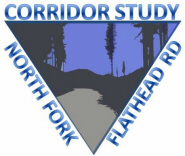
What is a Corridor Planning Study?
A Corridor Planning Study is a high-level evaluation of safety, environmental and geometric concerns along a transportation corridor where needs, possible improvement options and costs are identified before a project can proceed. Community input and consensus is an important consideration in this process. It is important to note that the Corridor Planning Study is part of a planning process and is not a design or construction project. Another consideration is how costs and the availability of funding affect the nature of any possible improvements and phasing of the possible improvements.
The North Fork Flathead Road (NFFR) Corridor Planning Study allowed for earlier planning-level coordination with the public, resource agencies and other entities. The study developed specific factors that can be used in the future if a subsequent environmental review process is required.
What does a "pre-NEPA Corridor Study" mean?
NEPA is the National Environmental Policy Act. Modeled after NEPA, MEPA is the Montana Environmental Policy Act, and it only applies to state agencies and state actions. NEPA is a federal law that outlines policies, goals, and procedures to insure environmental information is available to public officials and citizens before decisions are made and actions are taken. The NEPA process is intended to assist public officials in making decisions taking into account the human and natural environment and the public's need for safe and efficient transportation. The NFFR Corridor Study is a pre-NEPA/MEPA study that will include a high level environmental scan of potential issues.
Who conducted this study?
Flathead County, with support from Montana Department of Transportation (MDT), conducted this study. Parsons Brinckerhoff (PB) assisted Flathead County and MDT in completing the planning effort by the end of August, 2010.
Who has ownership and responsibility for maintenance of this stretch of the North Fork Flathead Road (NFFR)?
The portion of the NFFR being studied is on the State of Montana's Secondary Highway System 486 (S-486). S-486 is a major collector and serves as the north-south corridor between Columbia Falls and the Camas Road intersection that leads into Glacier National Park. This portion of the route is also designated as Forest Highway 61. The NFFR continues north from the Camas Road intersection to the Canadian border and is designated as a local road.
From Columbia Falls to RP 12.3 (end of pavement), the NFFR is maintained by state forces. From the end of pavement to Camas Road, it is maintained by Flathead County. From Camas Road to the Canadian Border, it is a local road and maintained by Flathead County.
Due to the MDT Secondary Road designation and Forest Highway designation, the portion of the route from Columbia Falls to the Camas Road intersection is eligible for Secondary Capital Construction Program funding through MDT and the Forest Highway Construction Program funding through Western Federal Lands Highways Division, a branch of the Federal Highways Administration. The portion north of Camas Road intersection is the responsibility of Flathead County. View study area map
What steps were taken during the Corridor Study?
The following steps were followed to produce an effective corridor study plan. These include:
- Identify corridor study candidate. Over the years, the NFFR corridor north of Columbia Falls, Montana has generated much discussion among local residents regarding the purpose and role this corridor plays in the region. Due to the high level of concern, this corridor has been identified for further study by Flathead County and MDT.
- Develop corridor study work plan. The planning team will assess the complexity of issues within the corridor and the level of effort required to address the issues.
- Develop existing and projected conditions report. The report will analyze existing and projected conditions, incorporate findings from an environmental scan, and consider local community vision, goals and objectives. Perceived corridor deficiencies, known impacts and potential mitigation opportunities will be documented as part of the report.
- Identify needs, issues, impacts, goals, and screening criteria. The planning team will consider comments from resource agencies and public involvement to develop screening criteria and objectives for improvement options analysis. The screening criteria will be related to the identified needs, issues, impacts, goals, costs, and funding and resources available.
- Determine improvement options advanced and not advanced. The planning team will analyze each improvement option using the identified screening criteria leading to a selection of preliminary improvement options advanced and not advanced.
- Recommend improvement options. The planning team will recommend potential improvement options (if any) for NFFR. Potential impacts, mitigation opportunities and estimated costs will be identified for each option.
- Prepare draft corridor study report. Based on key findings, needs, screening criteria, and recommendations, the planning team will develop a draft corridor study report. Input and comments on the draft report will be obtained from resource agencies, stakeholders, and through public involvement.
- Make recommendations. The planning team will finalize the corridor study report. This Corridor Planning Study may then transition forward to implementation.
What happens next?
The study serves only as a planning process, not a design or environmental project. Based on the results of the study, Flathead County will determine what, if any action to pursue.
